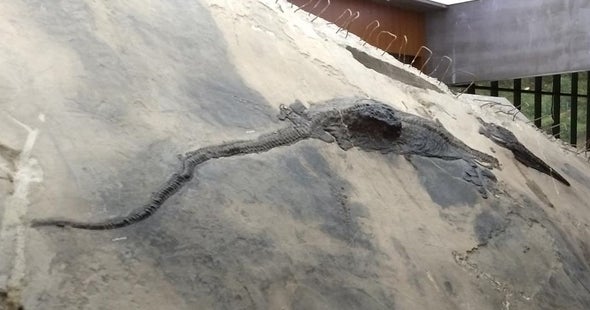(单词翻译:单击)
听力文本
This is Scientific American's 60-second Science, I'm Christopher Intagliata.
Hundreds of millions of years ago, reptilian predators called ichthyosaurs swam the seas. Their fossils look fearsome. But paleobiologist Ryosuke Motani of U.C. Davis says they may have looked more like friendly dolphins.
"Maybe in life ichthyosaurs would have been cute—at least the smaller ones."
Motani's team studied one such specimen found in southwest China. It was 240 million years old—15 feet long. But it seemed to have some extra bones in it—which Motani's team determined to be the remains of a 13-foot-long thalattosaur, or "sea lizard," the ichthyosaur had swallowed.
And, spoiler alert, the only reason they were able to see this animal in the belly of the ichthyosaur is that this gigantic meal never got digested. The ichthyosaur died soon after swallowing it.
Motani was careful to say they're not sure exactly why the ichthyosaur perished. But the specimen has a broken neck. So he gave a speculative play-by-play. Perhaps, he says, the ichthyosaur snapped at the sea lizard, but the lizard fought back.
"And this fight between the two was fierce, probably."

So the ichthyosaur fought to subdue its prey, damaging its neck in the process. Then it had to dislodge the prey's bony head and tail from its juicy midsection.
"Now the predator had to do it through jerking and twisting like crocodiles do."
Also bad for the neck. And finally, the ichthyosaur had to swallow the animal—perhaps using inertia or gravity to shove the prey down its gullet.
"And the chances are, by the time it was ingested, maybe the neck damage had accumulated to a certain level and maybe the neck could not support the head."
Details of that ancient battle appear in the journal iScience.
The reason this analysis matters is you can only infer so much about who ate who by looking at teeth. This fossil offers direct evidence that these ancient beasts sometimes bit off a whole lot more than they could chew.
Thanks for listening for Scientific American's 60-second Science. I'm Christopher Intagliata.
参考译文
这里是科学美国人——60秒科学系列,我是克里斯托弗·因塔格里塔。
亿万年前,名为“鱼龙”的爬行动物捕食者在海洋中游动。它们的化石看起来很可怕。但美国戴维斯大学的古生物学专家藻谷亮介表示,它们看起来可能更像友好的海豚。
“也许在生活中,鱼龙会很可爱——至少体型较小的是如此。”
藻谷亮介的团队研究了在中国西南部发现的鱼龙化石。这有2.4亿年历史,15英尺长。但它体内似乎有一些多余的骨头,藻谷亮介的团队确定那是鱼龙吞下的、13英尺长的海龙或“海蜥蜴”的遗骸。
剧透一下,他们能在鱼龙腹部看见这种动物的唯一原因是,这顿大餐从未被消化。鱼龙吞下它后不久就死了。
藻谷亮介谨慎地表示,他们不确定鱼龙死亡的确切原因。但这个标本的颈部骨折了。因此他给出了推测性解释。他说,也许鱼龙咬住了海蜥蜴,但蜥蜴反击了。
“它们俩之间的战斗可能很激烈。”
因此,鱼龙奋力制服自已的猎物,在这个过程中损伤了脖子。之后,鱼龙不得不将猎物多骨的头部和巴马从多汁液的中段卸掉。
“现在捕食者不得不像鳄鱼一样,通过猛拉和扭转扯掉它们。”
这对脖子也不利。最后,鱼龙必须吞掉这个动物,可能利用了惯性或重力将猎物推入食道。
“很有可能在吞下猎物时,鱼龙脖子的损伤已累积到一定程度,无法再支撑其头部。”
这场古代争斗的细节刊登在《iScience》上。
这篇分析很重要,因为你只能通过观察牙齿来推断谁吃了谁。这些化石提供了直接的证据,证明这些古老的野兽有时咬下的东西比它们能咀嚼的要多得多。
谢谢大家收听科学美国人——60秒科学。我是克里斯托弗·因塔利亚塔。
译文为可可英语翻译,未经授权请勿转载!
重点讲解
重点讲解:
1. at least (表示更正或改变自己刚说过的话)至少,起码;
It's not difficult to get money for research or at least it's not always difficult.
争取到研究资金并不难,起码不总是那么难。
2. be able to do sth. 可以…的,能够…的;
He should be able to lead a perfectly normal life.
他应该能够过上完全正常的生活。
3. fight back 反击;还击;
He ducked the first few blows then started to fight back.
他躲开最先几拳后便开始反击。
4. bite off 咬掉;
He was so hungry, he wanted to bite off half of my hamburger.
他是如此的饿,他想要将我的汉堡咬掉一半。
关注微信公众号【可可双语精读】,获取详细讲解内容


